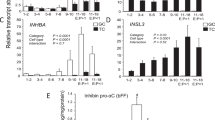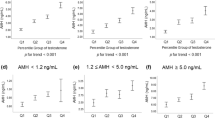Abstract
THE negative feedback action of testicular steroids on circulating levels of luteinising hormone (LH) is well known. It is less clear how the testis influences follicle-stimulating hormone (FSH). The existence of ‘inhibin’, a water-soluble testicular product that inhibits the secretion of FSH, was first postulated in 1932 (ref. 1); recently, inhibin activity has been detected in rete testis fluid2, testicular tissue3, spermatozoa4 and seminal plasma5. Immunisation of rabbits with the inhibin fraction of bull seminal plasma has produced an antiserum which raised plasma FSH levels when injected into male and female rats6. It has been suggested7 that, in the male, inhibin may be produced by the Sertoli cells of the testis. If this is the case, one wonders if inhibin could also be produced by granulosa cells of the ovary. We have, therefore, looked for the presence of a specific FSH-suppressing agent in ovarian follicular fluid by comparing the effects of fluid and peripheral plasma on the levels of FSH and LH in newly castrated male rats.
This is a preview of subscription content, access via your institution
Access options
Subscribe to this journal
Receive 51 print issues and online access
$199.00 per year
only $3.90 per issue
Buy this article
- Purchase on Springer Link
- Instant access to full article PDF
Prices may be subject to local taxes which are calculated during checkout
Similar content being viewed by others
References
McCullagh, D. R., Science, 76, 19–20 (1932).
Setchell, B. P., and Jacks, F., J. Endocr., 62, 675–676 (1974).
Lee, V. W. K., Keogh, E. J., and de Kretser, D. M., IRCS (Endocr., Physiol., Reprod.), 2, 1406 (1974).
Lugaro, G., Casellato, M. M., Mazzola, G., Fachini, G., and Carrea, G., Neuroendocrinology, 15, 62–68 (1974).
Franchimont, P., Chari, S., and Demoulin, A., J. Reprod. Fert., 44, 335–350 (1975).
Franchimont, P., Chari, S., Hagelstein, M. T., and Duraiswami, S., Nature, 257, 402–404 (1975).
Christiansen, P., Acta endocr. (Kbh), 78, 180–191 (1975); De Jong, F. H., and Sharpe, R. M., Fifth Int. Congr. Endocr., Abstract No. 514 (Brühlsche Universitätsdruckerei, Giessen, 1976).
Short, R. V., J. Endocr., 23, 401–411 (1962).
Caravaglios, R., and Cilotti, R., J. Endocr., 15, 273–278 (1957).
Welschen, R., et al., J. Endocr., 64, 37–47 (1975).
Peters, H., Ann. Biol. anim. Biochim. Biophys., 13, suppl., 167–176 (1973).
Bloom, A. M., and Mukherjee, B., Expl Cell Res., 74, 577–582 (1972).
Grumbach, M. M., Grave, G. D., and Mayer, F. E., (eds), The Control of the Onset of Puberty (Wiley, New York, 1974).
Author information
Authors and Affiliations
Rights and permissions
About this article
Cite this article
DE JONG, F., SHARPE, R. Evidence for inhibin-like activity in bovine follicular fluid. Nature 263, 71–72 (1976). https://doi.org/10.1038/263071a0
Received:
Accepted:
Issue Date:
DOI: https://doi.org/10.1038/263071a0
This article is cited by
-
Recent advances in the human physiology of inhibin secretion
Journal of Endocrinological Investigation (1990)
-
Complementary DNA sequences of ovarian follicular fluid inhibin show precursor structure and homology with transforming growth factor-β
Nature (1985)
Comments
By submitting a comment you agree to abide by our Terms and Community Guidelines. If you find something abusive or that does not comply with our terms or guidelines please flag it as inappropriate.



